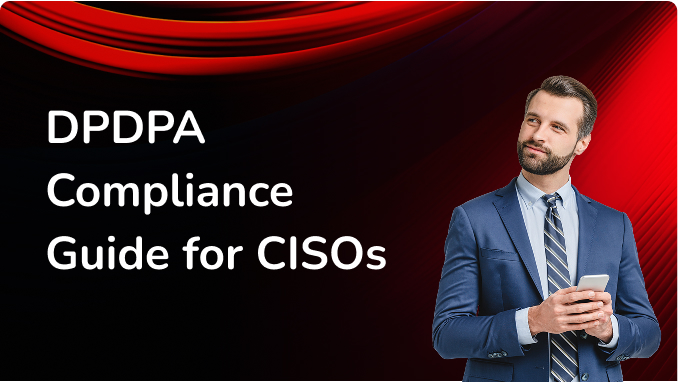Moving Beyond Tick-Boxes: Real-world DPDPA Strategies for CISOs
India’s DPDPA 2023 brought a major change in how companies must handle personal data. For Chief Information Security Officers (CISOs), this law introduces both responsibilities and opportunities, so this law is not just about following rules but it’s about taking active responsibility for how personal data is protected across the organisation. This law moves data protection from a regulatory checkbox to a business-critical function that requires risk management and cross-functional coordination.

This blog mainly focuses on how CISOs can build practical and effective strategies that go beyond meeting the compliance requirements.
The India’s DPDPA is main law for protecting people’s personal data especially the digital form of data. It applies to any organisation that collects or processes or uses the personal data. And it is India’s first comprehensive digital privacy law that applies to all organisations that collects and processes the personal digital data. And this law is often linked to take consent form individuals as it goes much further which requires organisations to:
- Collect data only for clear and valid reasons which is called purpose data limitation.
- Avoid collecting irrelevant or more data than needed which is called data minimization
- Put strong security safeguards or controls in place to protect personal data.
- Respect individual’s rights like letting people access fix or delete their personal data.
For CISO’s this means that data privacy is not just a legal matter, but now privacy overlaps deeply with information.
Traditionally in privacy compliance the legal teams draft the policies and IT teams deploy technical controls or add some security features like encryption or firewalls, which is no longer sufficient. The new law DPDPA gives people more rights over their personal data and gives more responsibility on companies which is called data fiduciaries and imposed duties on these fiduciaries that require continuous, adaptive and proactive controls and this is exactly where CISOs must have to lead the charge.
Due to this, the privacy must have to built into systems and workflows right from the very beginning. Because it is no longer sufficient or enough by simply relying on basic encryption or access controls. Even organizations must practice the Privacy by Design by incorporating privacy related considerations during the product development process. This shift would definitely require closer collaboration among CISOs, developers and other stakeholders.
Achieving visibility into personal data across the organization or enterprises would be one of the very important duty or tasks under DPDPA. Complying to DPDPA is to gain clear understanding of how personal data is collected, stored, used and shared across the enterprise. Many organisations still find it challenging to answer basic questions like:
- Where is our personal data stored?
- Who is having access to it?
- Why do we even collect it?
It is CISO duty or at least they should take the lead in using the tools that automatically labels the personal data across the organisation. This will help in building a clear inventory of what data the company has and where it is stored.
According to the DPDPA, consent is no longer just a checkbox present inside a terms and conditions page. Most of the organisations still treat the consent as a long terms and conditions page which is no longer acceptable.
CISOs should work closely with legal and product teams to meet this requirement to setup a centralized consent dashboards which is a place where the user can see what the have agreed to and can make changes or even can withdraw their consent.
One of the biggest challenges which is also the biggest opportunity for the organisations is to make the privacy a part of the company culture but not just a legal requirement. Having policies and tools is very much important, unless the employees understand and support them across the organization, they won’t be much effective.
CISOs can play a role here by helping to build this as a culture by offering privacy training which is tailored to each department or team and by creating a simple way for the employees to report their concerns or even can suggest the improvements.
Every single individual in the company will plays a major role in protecting personal data from the developers who builds the software to hr teams who manages the employee information. Organizations are most likely stays compliant whenever the privacy becomes a part of how people work every single day towards it and when leadership team supports it.
Getting DPDPA compliance right isn’t just about ticking boxes, it’s about understanding how the law applies to your specific business and putting practical systems in place. That’s where Azpirantz can really make a difference.
Our team works closely with organizations to simplify complex privacy requirements and build solutions that actually work in real-world scenarios. From setting up consent flows to preparing for audits, we help you stay compliant without slowing down your operations.
Need support getting started?
Explore India DPDPA Consulting Services
*This content has been created and published by the Azpirantz Marketing Team and should not be considered a professional advice. For expert consulting and professional advice, please reach out to [email protected].
We're Here To Help